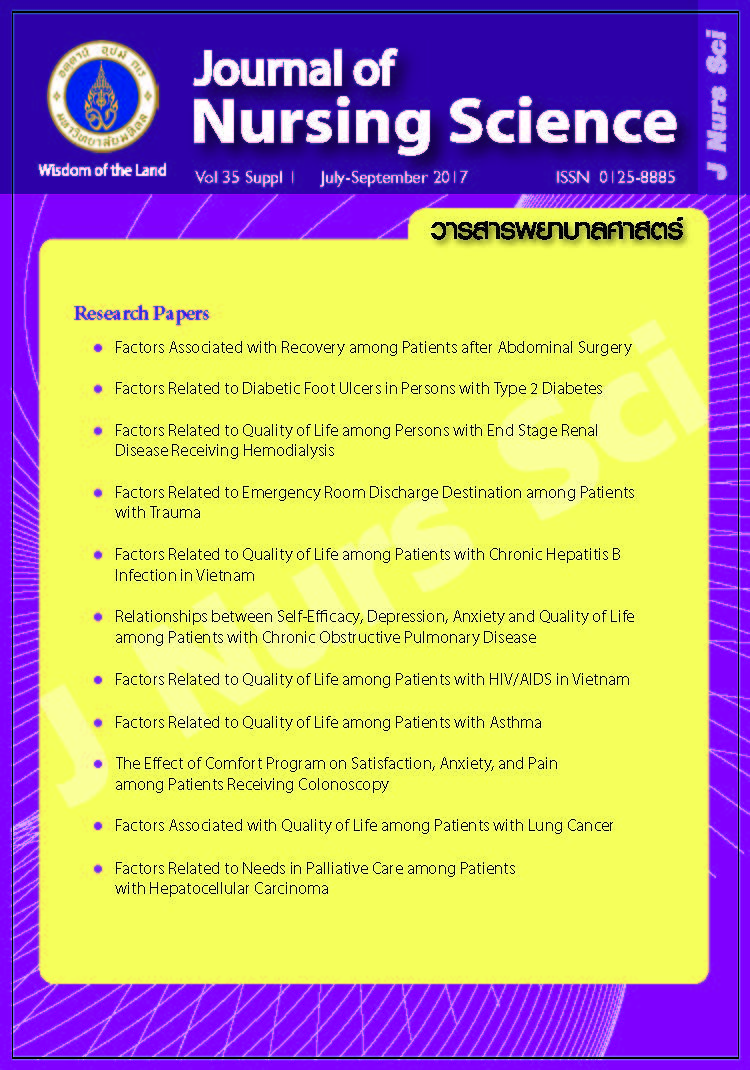The Effect of Comfort Program on Satisfaction, Anxiety, and Pain among Patients Receiving Colonoscopy ผลของโปรแกรมส่งเสริมความสุขสบายต่อความพึงพอใจ ความวิตกกังวล และความปวดของผู้ป่วยที่ได้รับการส่องกล้องตรวจลำไส้ใหญ่
Main Article Content
Abstract
Purpose: To evaluate the effect of comfort program on satisfaction, anxiety, and pain among patients receiving colonoscopy.
Design: A quasi-experiment design.
Methods: The sample was 152 patients both males and females with the age of 18 years and older who received colonoscopy at the Functional Examination Department of Bach Mai Hospital, Hanoi, Vietnam. The sample was divided into control and experimental groups. The comfort program was provided to the experimental group, and the control group received routine care. Data were collected with 3 questionnaires: 1) Hamilton Anxiety Rating Scale, 2) Numerical Rating Scale, and 3) Group Health Association of America-9 survey. ANCOVA, Mann-Whitney U, and Chi-square test were used to analyze the data.
Main findings: There was significant difference of satisfaction and anxiety level between the control and experimental group after colonoscopy (p < .05). The majority of patients in the experimental group (75.9%) were satisfied with very good and 24.1% with excellent level. Pain levels increased to the mean score of 4.96 (SD = 2.02) in the experiment group and mean score of 6.41 (SD = 2.10) in the control group. However, there was no difference in pain perception between two groups.
Conclusion and recommendations: The comfort program shows an effectiveness to increase patients’ satisfaction and reduce anxiety. Thus, nurses should sustain this program by training all nurses and health care personal to improve the quality of patient’s care.
บทคัดย่อ
วัตถุประสงค์: เพื่อประเมินผลโปรแกรมส่งเสริมความสุขสบายต่อความพึงพอใจ ความวิตกกังวล และความปวดของผู้ป่วยที่ได้รับการส่องกล้องตรวจลำไส้ใหญ่
รูปแบบการวิจัย: วิจัยกึ่งทดลอง
วิธีดำเนินการวิจัย: กลุ่มตัวอย่างเป็นผู้ป่วยทั้งชายและหญิงอายุตั้งแต่ 18 ปีขึ้นไป รวม 152 คน ที่มารับการส่องกล้องตรวจลำไส้ใหญ่แบบไม่ได้ดมยาสลบ โรงพยาบาลแบคมาย เมืองฮานอย ประเทศเวียตนาม ผู้ป่วยถูกแบ่งเท่าๆ กันเป็นกลุ่มควบคุมและกลุ่มทดลอง กลุ่มทดลองได้รับโปรแกรมส่งเสริมความสุขสบาย กลุ่มควบคุมได้รับการดูแลตามปกติ เก็บข้อมูลจากแฟ้มผู้ป่วยและใช้แบบสอบถามวัดความวิตกกังวลของ Hamilton Anxiety Rating Scale วัดความปวดด้วย Numerical Rating Scale และความพึงพอใจด้วย Group Health Association of America-9 survey วิเคราะห์ข้อมูลด้วยสถิติ ANCOVA Mann-Whitney U test และไคสแควร์
ผลการศึกษา: ผู้ป่วยกลุ่มทดลองมีความพึงพอใจและความวิตกกังวลภายหลังได้รับการส่องกล้องตรวจลำไส้ใหญ่ แตกต่างจากกลุ่มควบคุมอย่างมีนัยสำคัญทางสถิติ (p < .05) ความพึงพอใจในบริการส่วนใหญ่อยู่ในระดับดีมากถึงดีเยี่ยม (ร้อยละ 75.9 และ 24.1) กลุ่มทดลองมีค่าเฉลี่ยของระดับความปวดเพิ่มขึ้นเป็น 4.96 (SD = 2.02) ขณะที่กลุ่มควบคุมคุมมีค่าเฉลี่ย 6.41 (SD = 2.10) แต่แตกต่างกันไม่มีนัยสำคัญทางสถิติ
สรุปและข้อเสนอแนะ: โปรแกรมส่งเสริมความสุขสบายมีประสิทธิภาพที่จะช่วยเพิ่มความพึงพอใจและลดความวิตกกังวลแก่ผู้ป่วย พยาบาลจึงควรนำโปรแกรมนี้มาใช้อย่างต่อเนื่องเพื่อเพิ่มคุณภาพการดูแล โดยเริ่มจากการจัดอบรมให้แก่พยาบาลและบุคลากรทุกคน
Article Details
Copyright Notice: Nursing Science Journal of Thailand has exclusive rights to publish and distribute the manuscript and all contents therein. Without the journal’s permission, the dissemination of the manuscript in another journal or online, and the reproduction of the manuscript for non-educational purpose are prohibited.

Disclaimer: The opinion expressed and figures provided in this journal, NSJT, are the sole responsibility of the authors. The editorial board bears no responsibility in this regard.
References
2. Friedman S, Cheifetz AS, Farraye FA, Banks PA, Makrauer FL, Burakoff R, et al. Factors that affect adherence to surveillance colonoscopy in patients with inflammatory bowel disease. Inflamm Bowel Dis. 2013;19(3):534-9.
3. Ferlay J, Autier P, Boniol M, Heanue M, Colombet M, Boyle P. Estimates of the cancer incidence and mortality in Europe in 2006. Ann Oncol. 2007;18(3):581-92.
4. Rastogi A, Wani S. Colonoscopy. Gastrointest Endosc. 2017;85(1):59-66.
5. Functional Examination Department, Bach Mai Hospital. Annual report of functional examination department 2014. Hanoi: Bach Mai Hospital; 2014.
6. Trevisani L, Zelante A, Sartori S. Colonoscopy, pain and fears: is it an indissoluble trinomial? World J Gastrointest Endosc. 2014;6(6):227-33.
7. Holme O, Bretthauer M, de Lange T, Seip B, Huppertz-Hauss G, Hoie O, et al. Risk stratification to predict pain during unsedated colonoscopy: results of a multicenter cohort study. Endoscopy. 2013;45(9):691-6.
8. Macintyre PE, Walker SM. The scientific evidence for acute pain treatment. Curr Opin Anesthesiol. 2010;23(5):623-8.
9. Sewitch MJ, Gong S, Dube C, Barkun A, Hilsden R, Armstrong D. A literature review of quality in lower gastrointestinal endoscopy from the patient perspective. Can J Gastroenterol. 2011;25(12):681-5.
10. Kolcaba K. Evolution of the mid range theory of comfort for outcomes research. Nurs Outlook. 2001;49(2):86-92.
11. Mertin S, Sawatzky JA, Diehl-Jones WL, Lee TW. Roadblock to recovery: the surgical stress response. Dynamics. 2007;18(1):14-20.
12. Arabulm M, Kandemir A, Çelik M, Alper E, Akpinar Z, Aslan F, et al. Impact of an information video before colonoscopy on patient satisfaction and anxiety. Turk J Gastroenterol. 2012;23(5):523-9.
13. Bechtold ML, Puli SR, Othman MO, Bartalos CR, Marshall JB, Roy PK. Effect of music on patients undergoing colonoscopy: a meta-analysis of randomized controlled trials. Dig Dis Sci. 2009;54(1):19-24.
14. Serper M, Gawron AJ, Smith SG, Pandit AA, Dahlke AR, Bojarski EA, et al. Patient factors that affect quality of colonoscopy preparation. Clin Gastroenterol Hepatol. 2014;12(3):451-7.
15. Sidhu S, Geraghty J, Karpha I, Wark L, Logan C, Sarkar S. Outcomes following an initial unsuccessful colonoscopy: a 5-year complete audit of teaching hospital colonoscopy practice. Gut. 2011;60 Suppl 1:A201.
16. Faul F, Erdfelder E, Buchner A, Lang AG. Statistical power analyses using G*Power 3.1: tests for correlation and regression analyses. Behav Res Methods. 2009;41(4):1149-60.
17. Katseesung P, Asdornwised U, Pinyopasakul W, Akaraviputh T. Effects of continuing care program on quality of bowel preparation and anxiety in who receiving ambulatory colonoscopy. Journal of Nursing Science. 2015;33(3):61-73.
18. Hamilton M. The assessment of anxiety states by rating. Br J Med Psychol. 1959;32(1):50-5.
19. McCaffery M, Beebe A. Pain: clinical manual for nursing practice. St. Louis, MO: Mosby; 1989. p.24-95.
20. [No authors listed]. Quality and outcomes assessment in gastrointestinal endoscopy. American Society for Gastrointestinal Endoscopy. Gastrointest Endosc. 2000;52(6):827-30.
21. Harewood GC, Wiersema MJ, de Groen PC. Utility of Web-based assessment of patient satisfaction with endoscopy. Am J Gastroenterol. 2003;98(5):1016-21.
22. Azmi N, Chan WK, Goh KL. Evaluation of patient satisfaction of an outpatient gastroscopy service in an Asian tertiary care hospital. BMC Gastroenterology. 2012;28(12):96. doi: 10.1186/1471-230X-12-96.
23. Triantafyllou K, Gkolfakis P, Triantafyllou M, Ndini X, Melissaratou A, Moustafa GA, et al. Long-term patient satisfaction of gastrointestinal endoscopic procedures. Ann Gastroenterol. 2016;29(2):188-95.
24. Carter XW, Topolski R, Hatzigeorgiou C, Fincher RK. Role of anxiety in the comfort of nonsedated average-risk screening sigmoidoscopy. South Med J. 2013;106(4):280-4.


